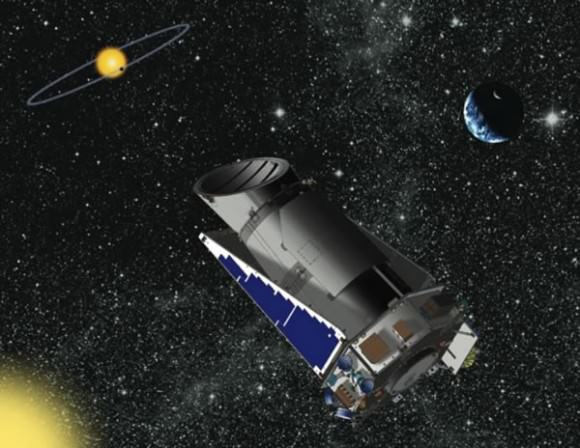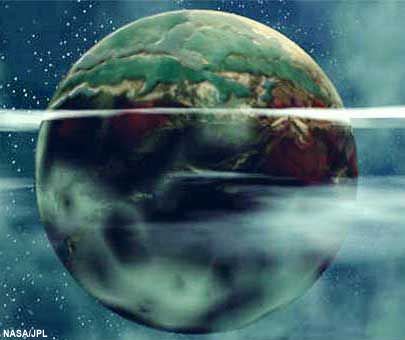
Artist concept of the Kepler telescope in orbit. Image Credit: NASA
Once again news from the Kepler mission is making the rounds, this time with a research paper outlining a theory that Earth-like planets may be more common around class F, G and K stars than originally expected.
In the standard stellar classification scheme, these type of stars are similar or somewhat similar to our own Sun (which is a Class G star); Class F stars are hotter and brighter and Class K stars are cooler and dimmer. Given this range of stars, the habitable zones vary with different stars. Some habitable planets could orbit their host star at twice the distance Earth orbits our Sun or in the case of a dim star, less than Mercury’s orbit.
How does this recent research show that small, rocky, worlds may be more common that originally thought?
Dr. Wesley Traub, Chief Scientist with NASA’s Exoplanet Exploration Program outlines his theory in a recent paper submitted to the Astrophysical Journal.

A possible habitable world? Credit: NASA/JPL
Based on Traub’s calculations in his paper, he formulates that roughly one-third of class F, G, and K stars should have at least one terrestrial, habitable-zone planet. Traub bases his assertions on data from the first 136 days of Kepler’s mission.
Initially starting with 1,235 exoplanet candidates, Traub narrowed the list down to 159 exoplanets orbiting F class stars, 475 orbiting G class stars, and 325 orbiting K class stars – giving a total of 959 exoplanets in his model. For the purposes of Traub’s model, he defines terrestrial planets as those with a radius of between half and twice that of Earth. The mass ranges specified in the model work out to between one-tenth Earth’s mass and ten times Earth’s mass – basically objects ranging from Mars-sized to the theoretical super-Earth class.
The paper specifies three different ranges for the habitable zone: A “wide” habitable zone (HZ) from 0.72 to 2.00 AU, a more restrictive HZ from 0.80 to 1.80 AU, and a narrow/conservative HZ of 0.95 to 1.67 AU.
After working through the necessary math of his model, and coming up with a “power law” that gives a habitable zone to a star depending on its class and then working out how many planets ought to be at those distances, Traub estimated the frequency of terrestrial, habitable-zone planets around Sun-like (Classes F, G and K) stars at (34 ± 14)%.
He added that mid-size terrestrial planets are just as likely to be found around faint stars and bright ones, even though fewer small planets show up around faint stars. But that is likely because of the limits of our currently technology, where small planets are more difficult for Kepler to see, and it’s easier for Kepler to see planets that orbit closer to their stars.
Traub discussed how the quoted uncertainty is the formal error in projecting the numbers of short-period planets, and that the true uncertainty will remain unknown until Kepler observations of orbital periods in the 1,000-day range become available.
Check out our previous coverage of exoplanet detections using the Kepler data at:http://www.universetoday.com/89120/big-find-citizen-scientists-discover-two-extrasolar-planets/
If you’d like to read Traub’s paper and follow the math involved in his analysis, you can do so at: http://arxiv.org/PS_cache/arxiv/pdf/1109/1109.4682v1.pdf
Learn more about the Kepler mission at: http://kepler.nasa.gov/
Source Universe Today
No hay comentarios:
Publicar un comentario